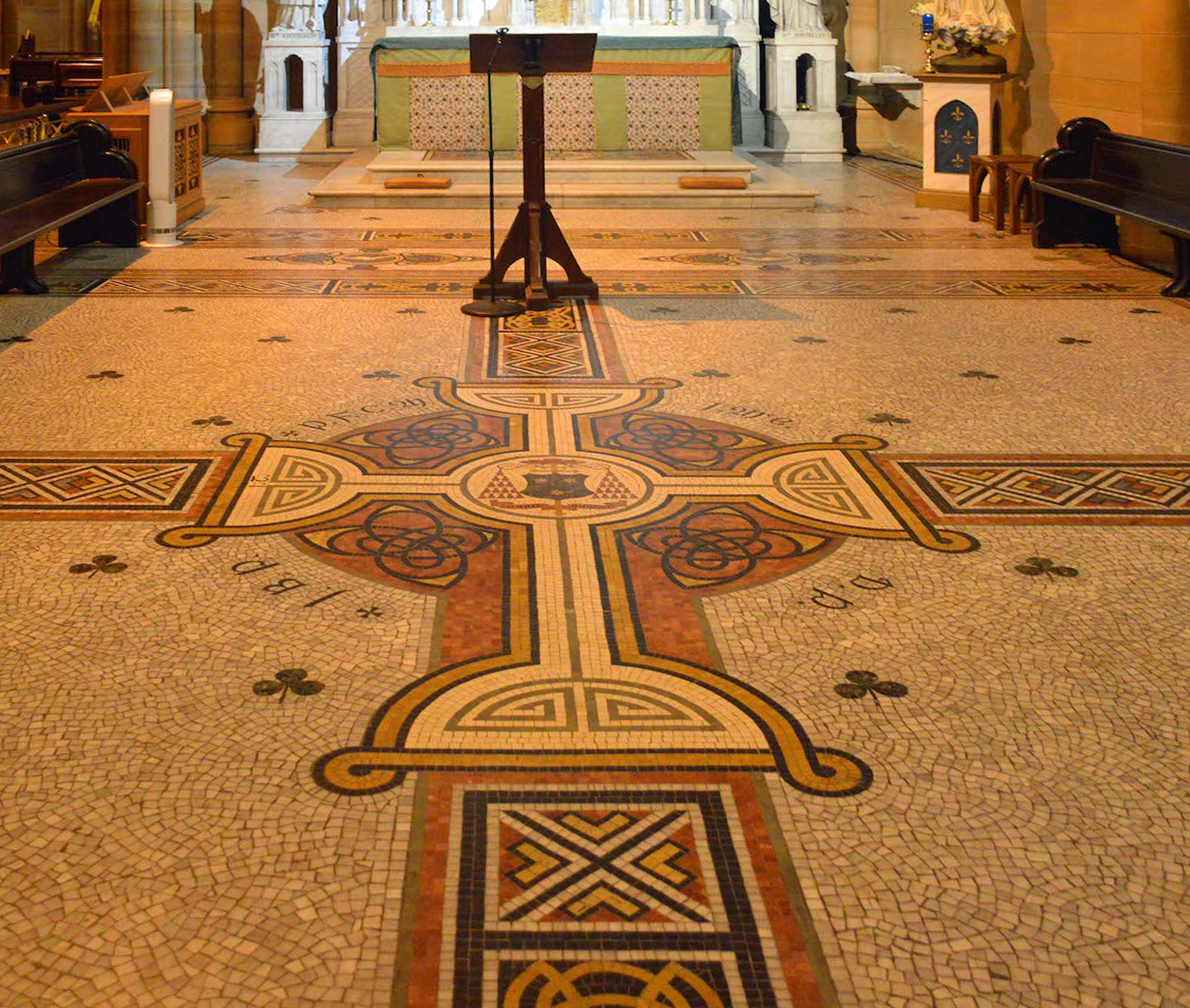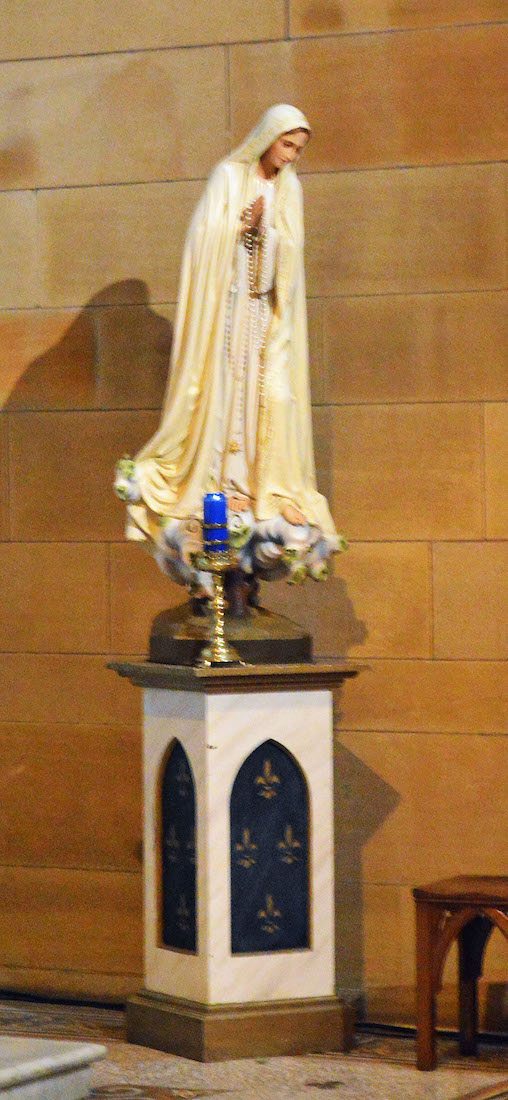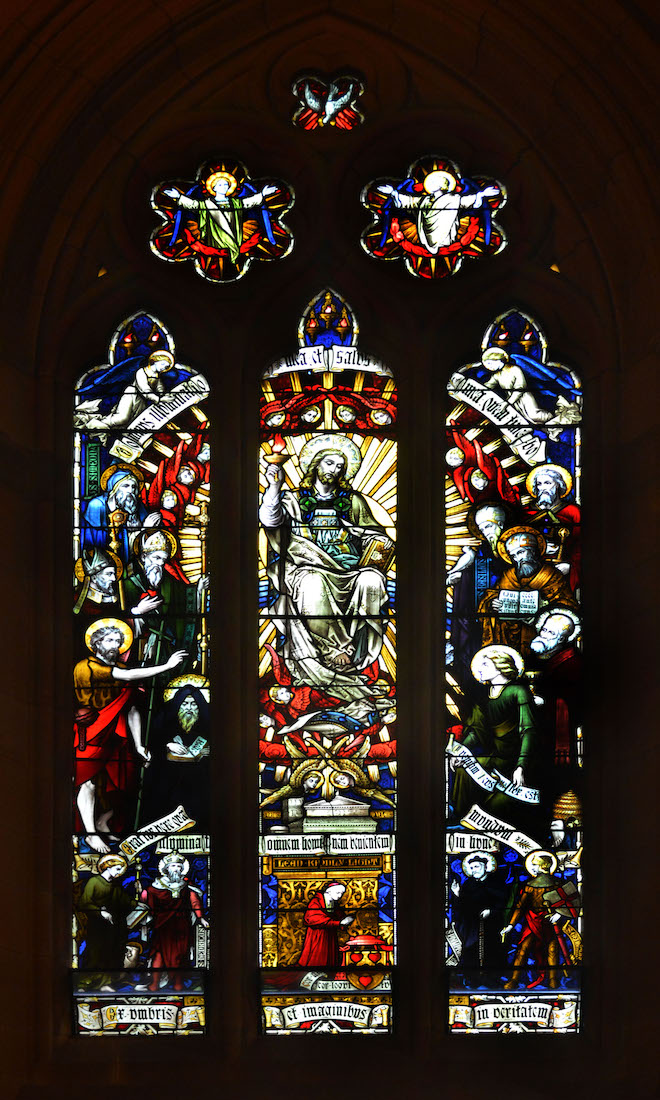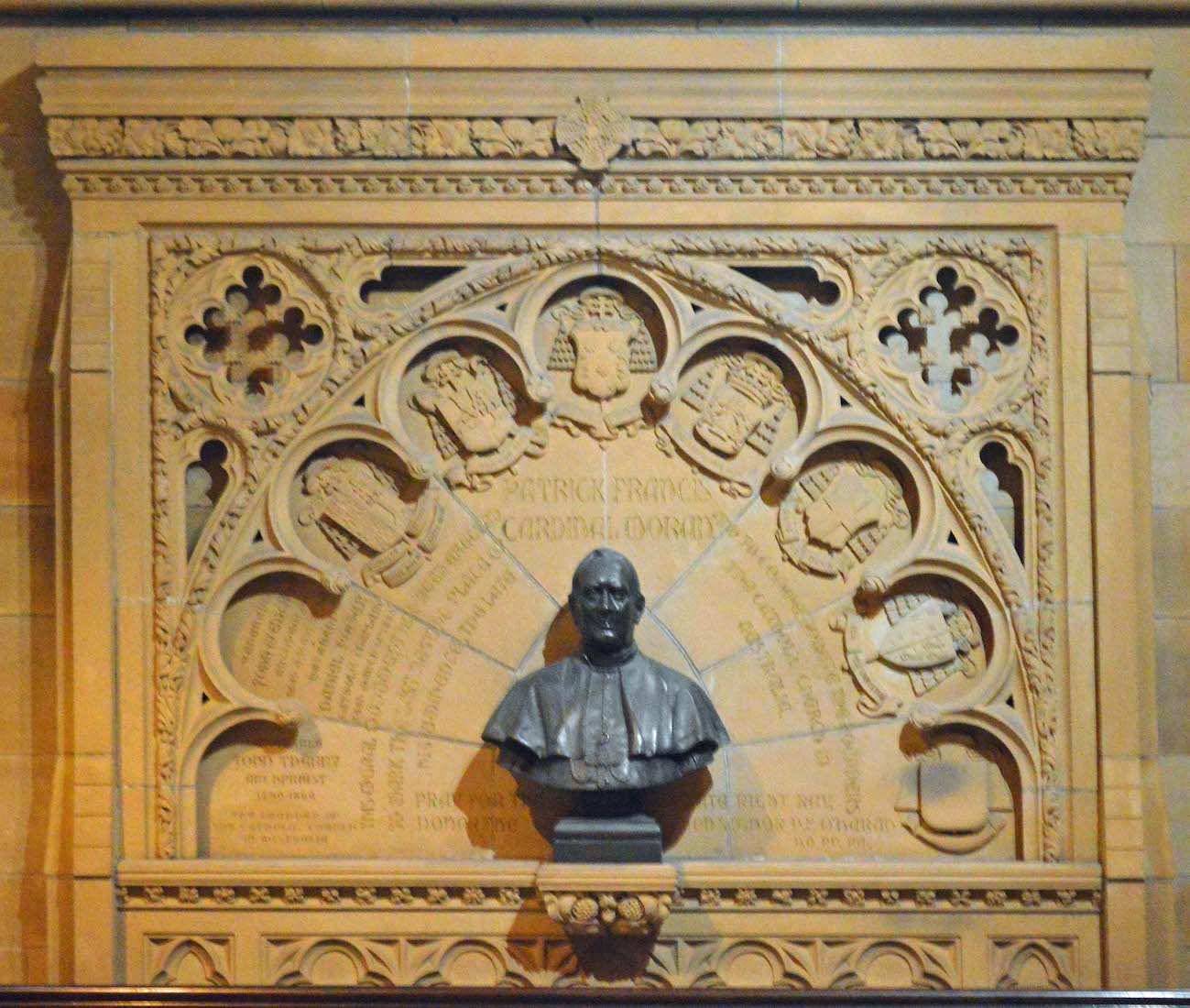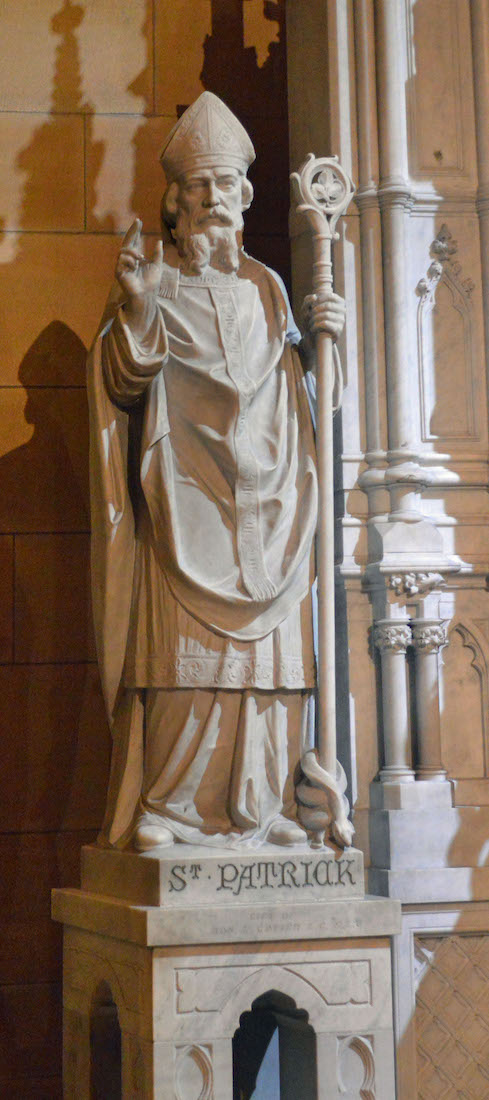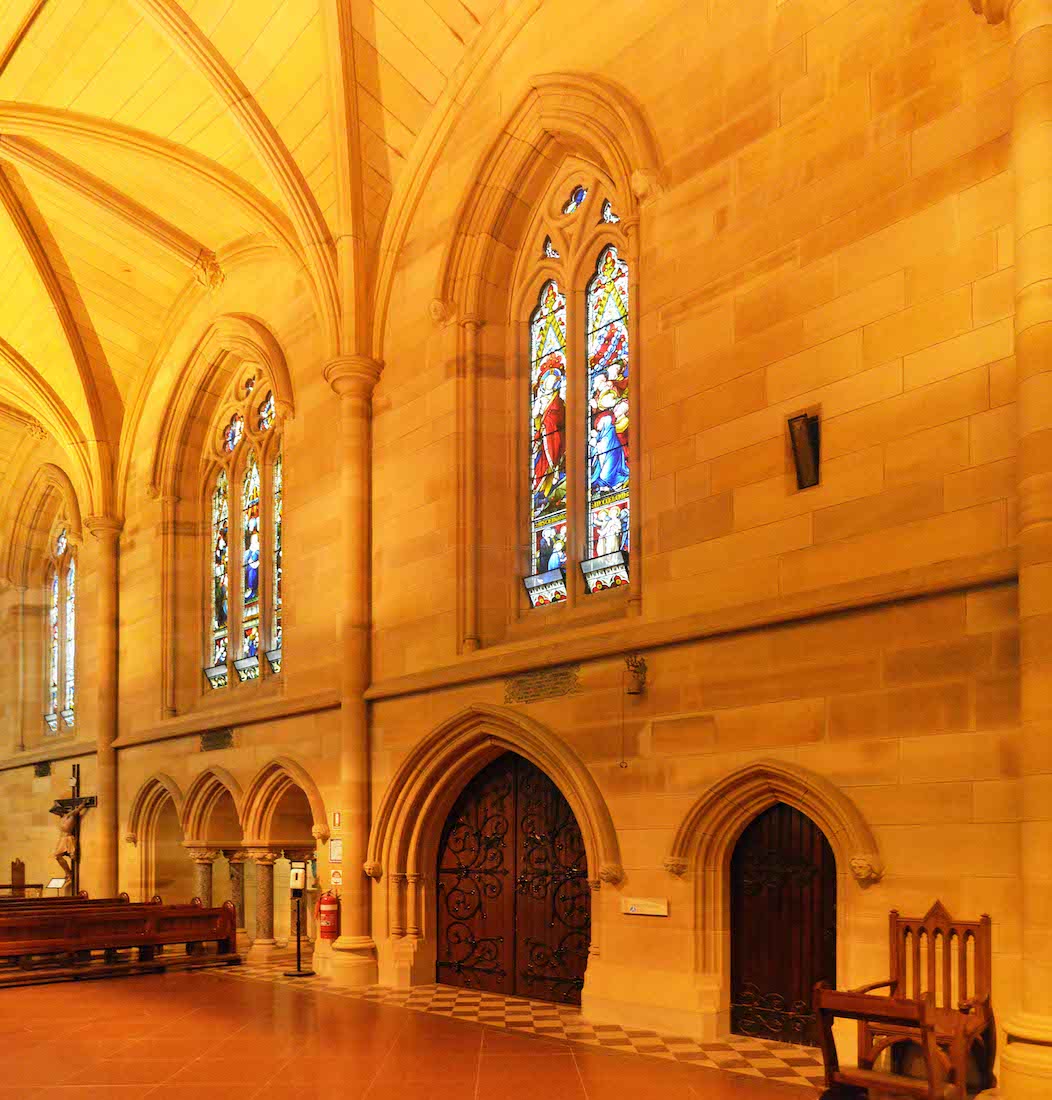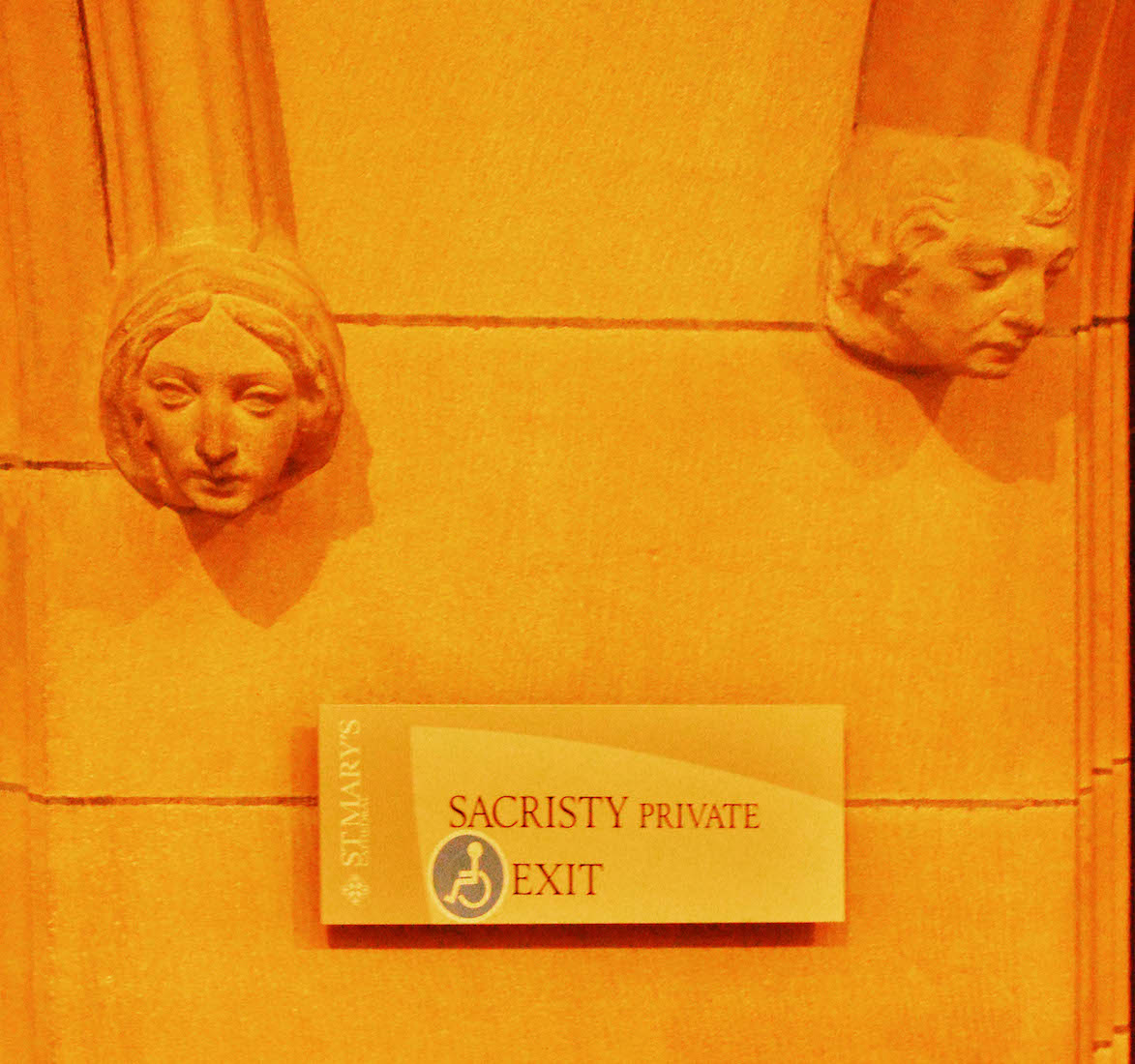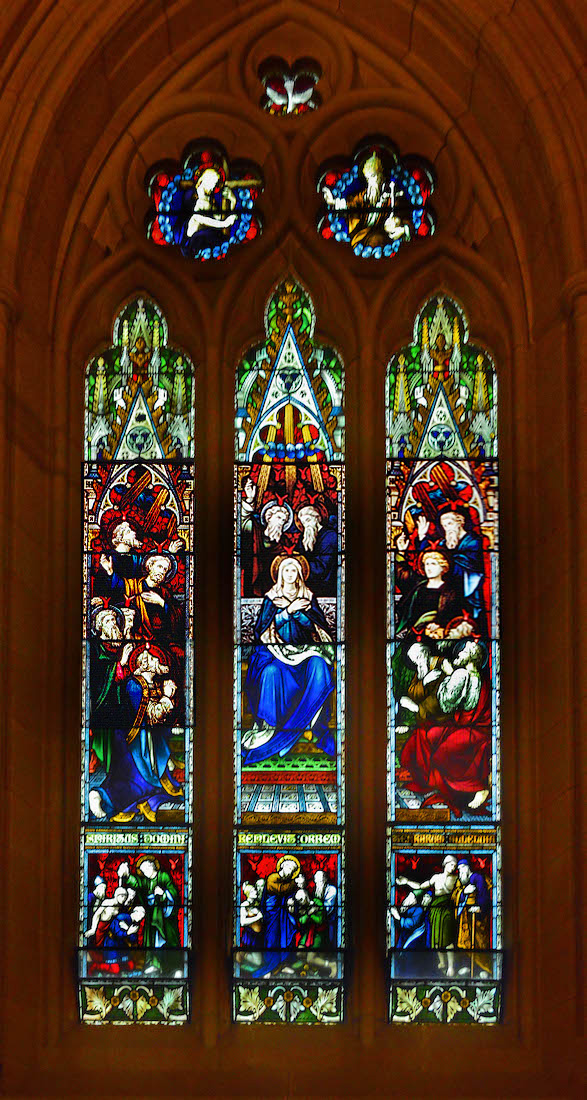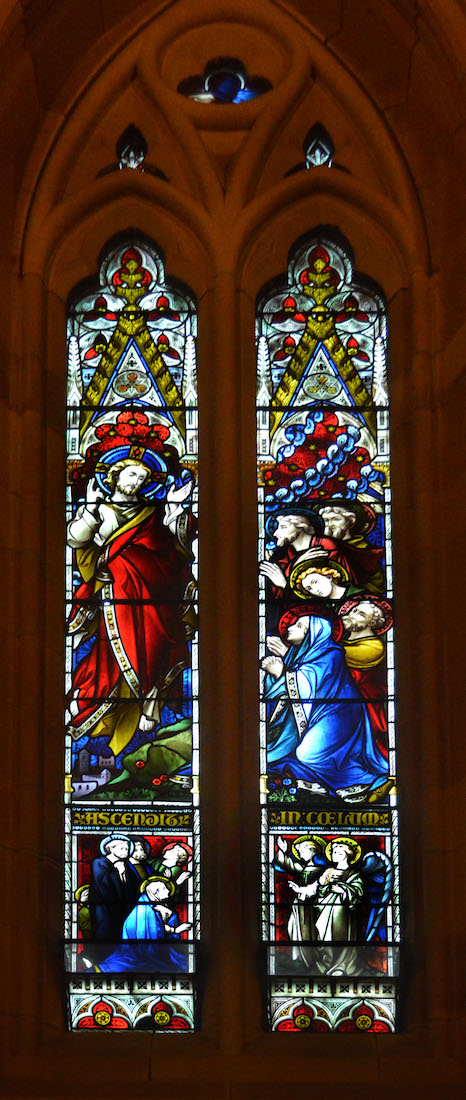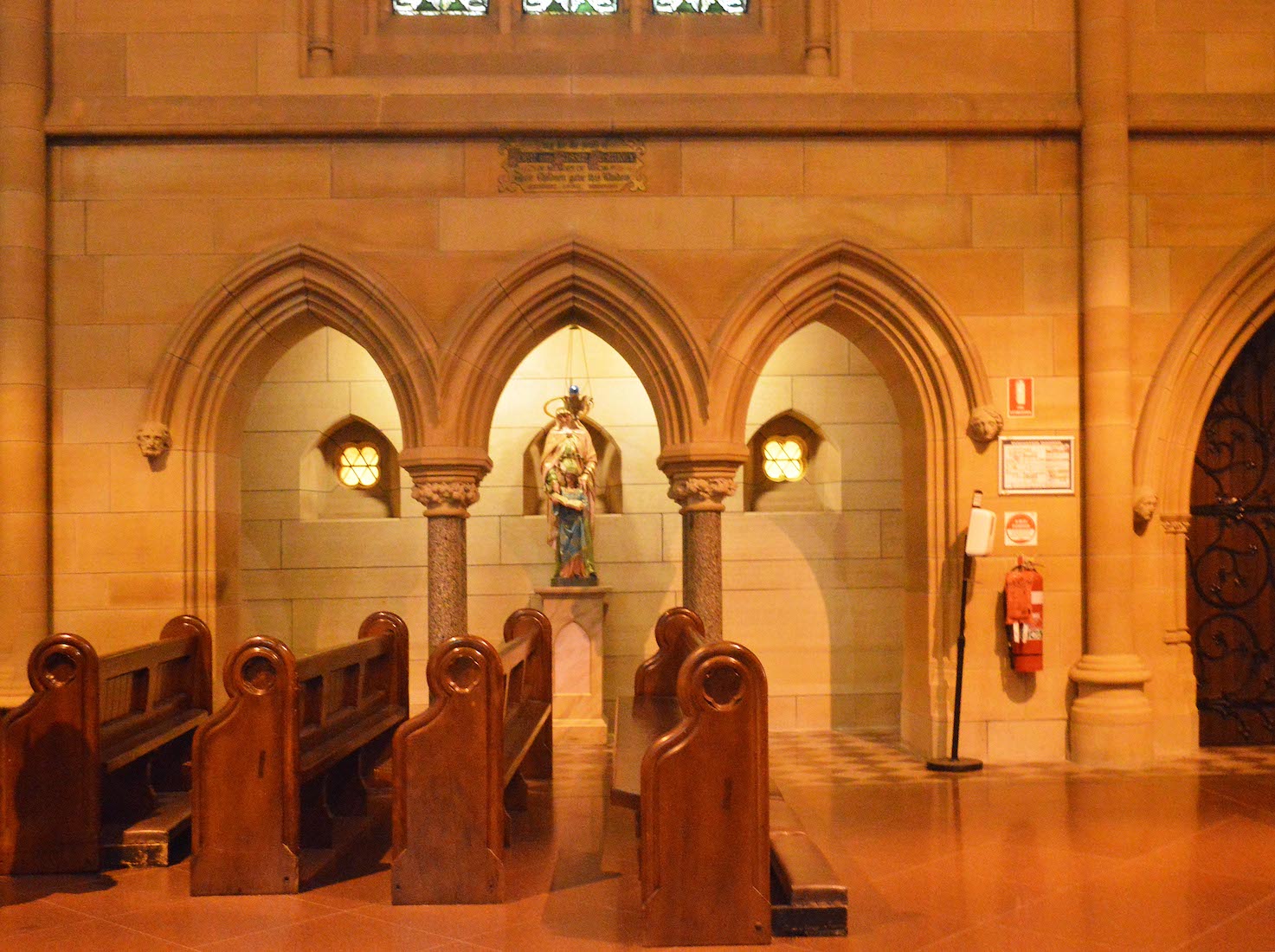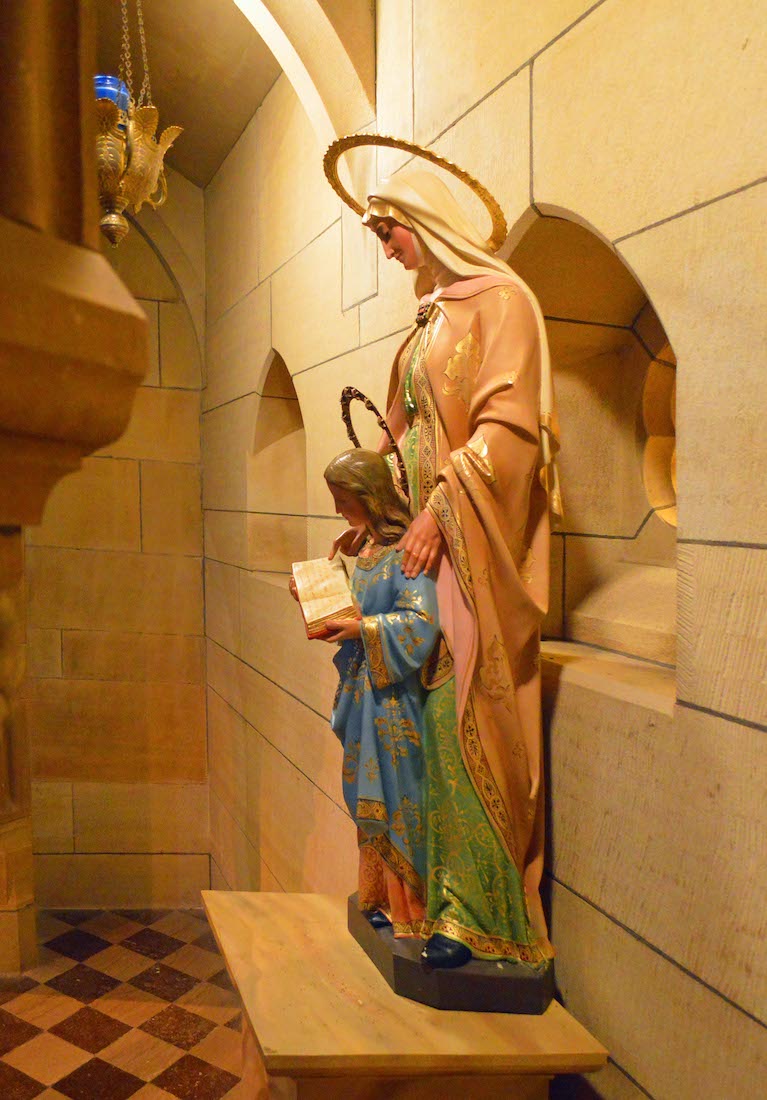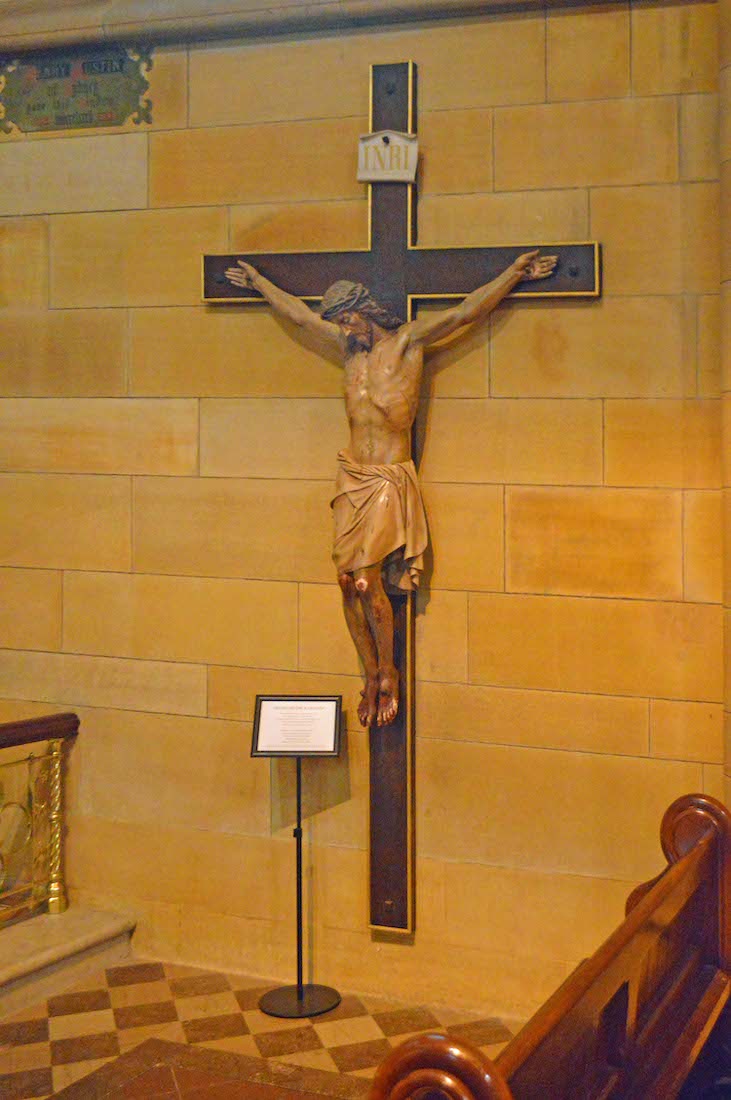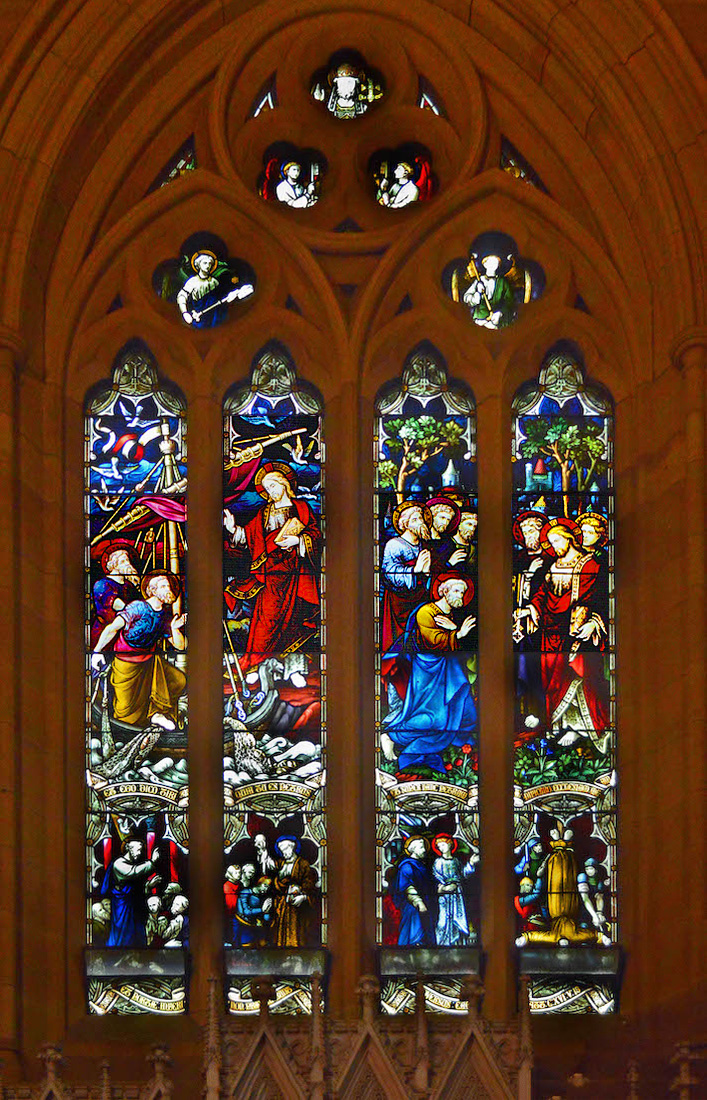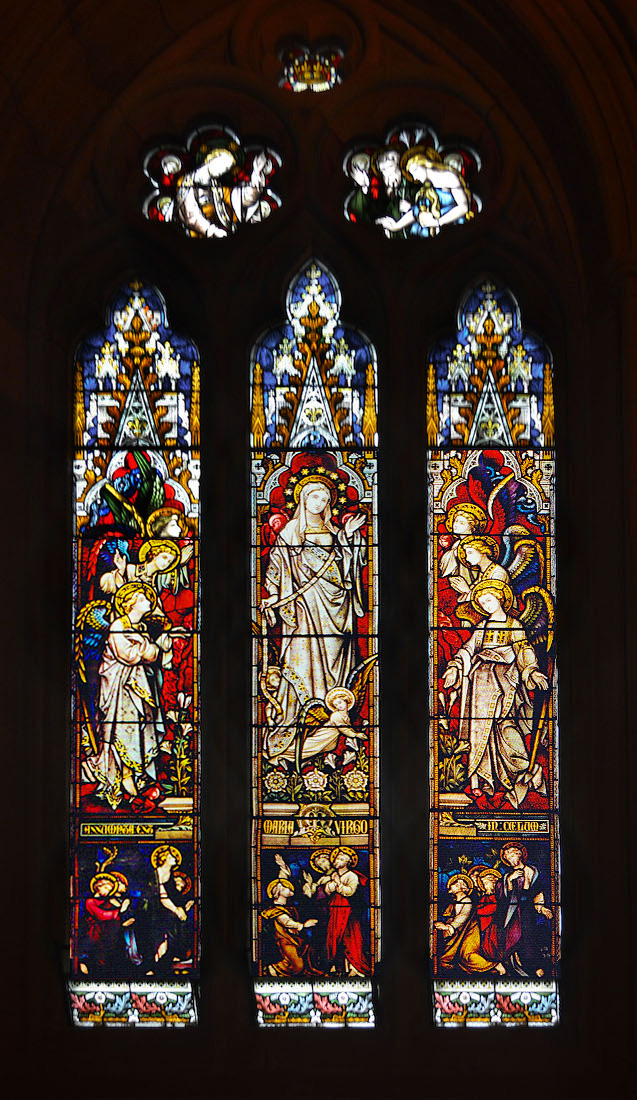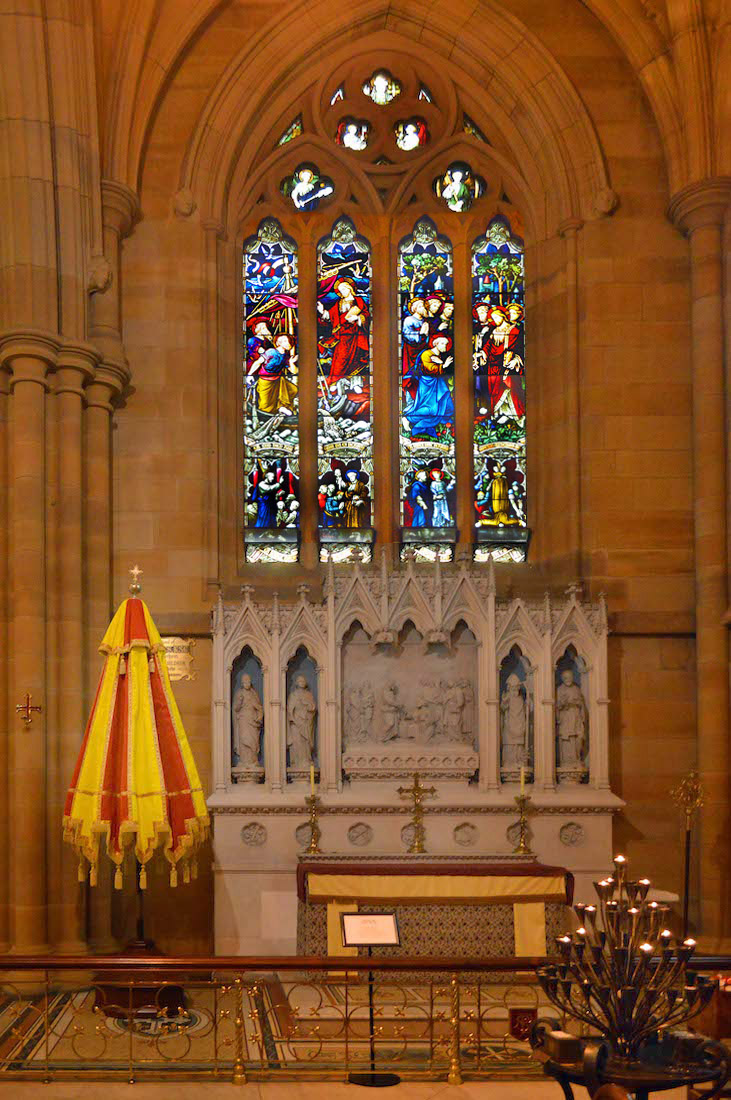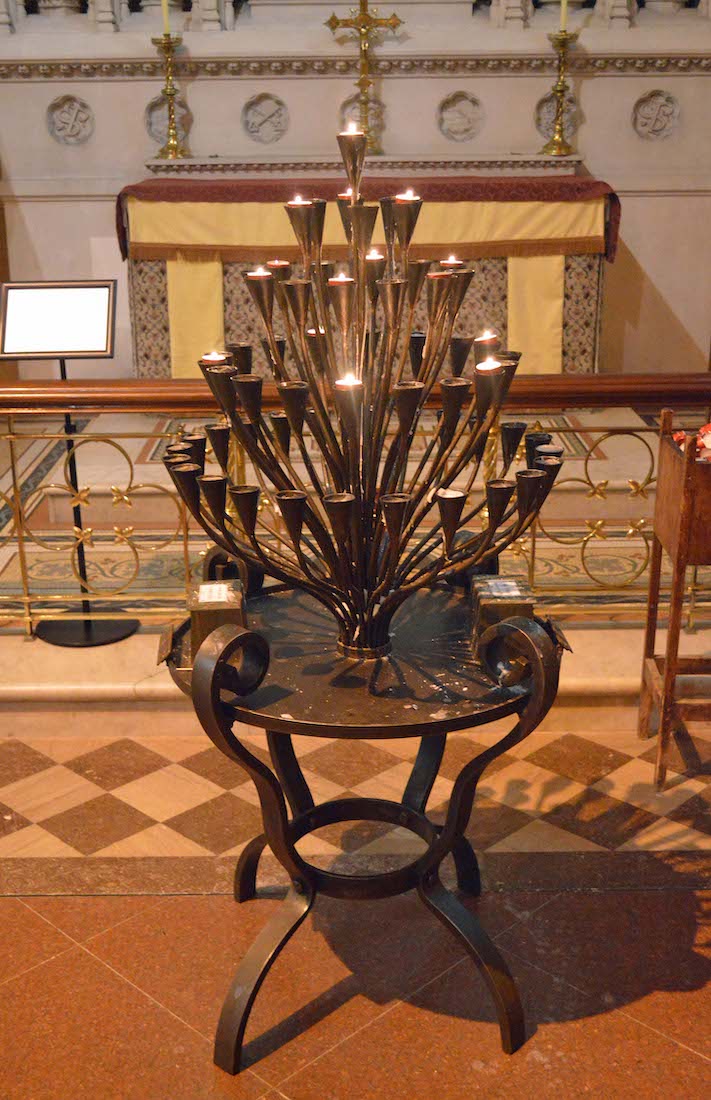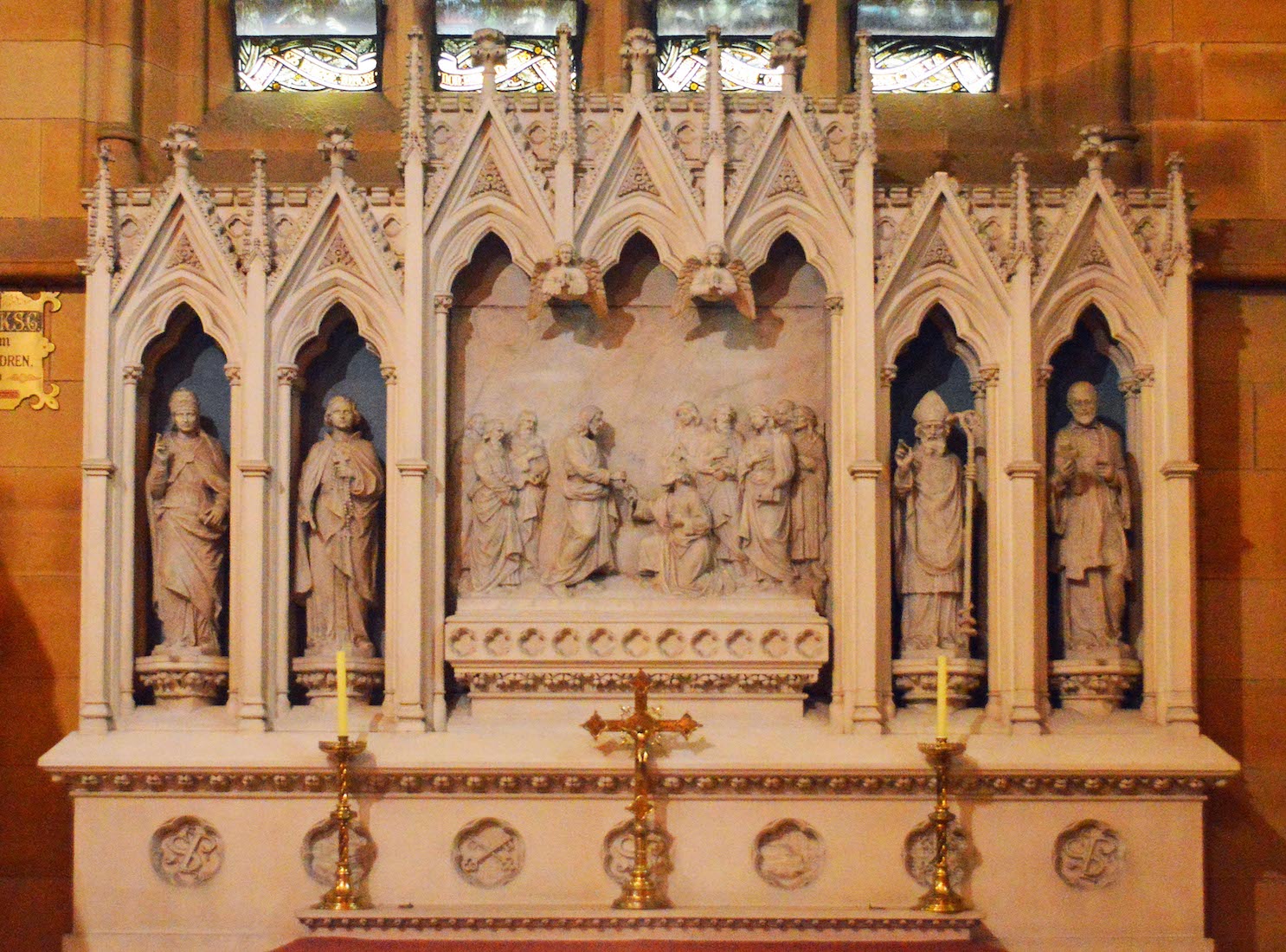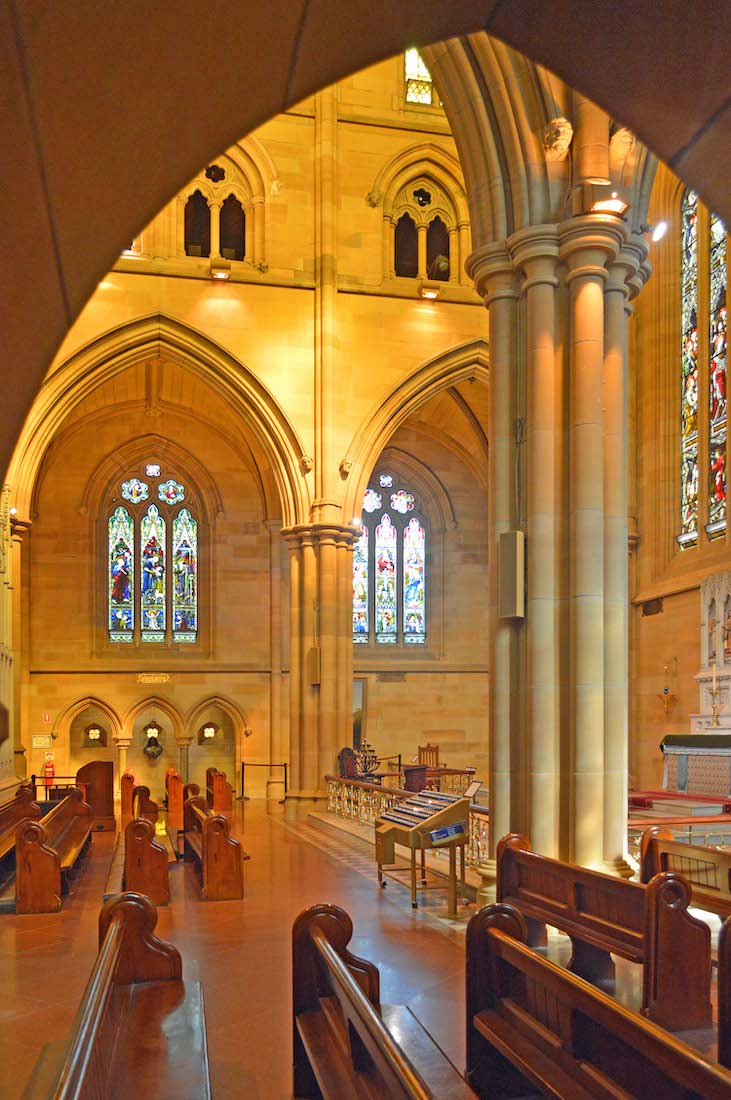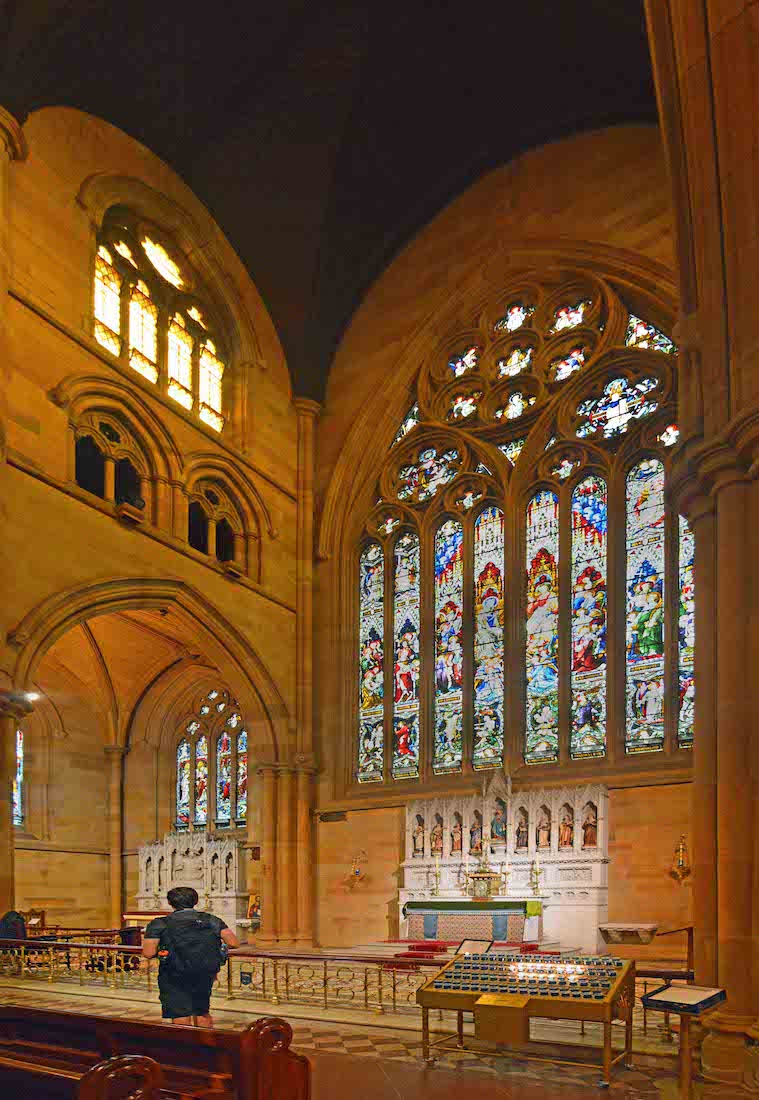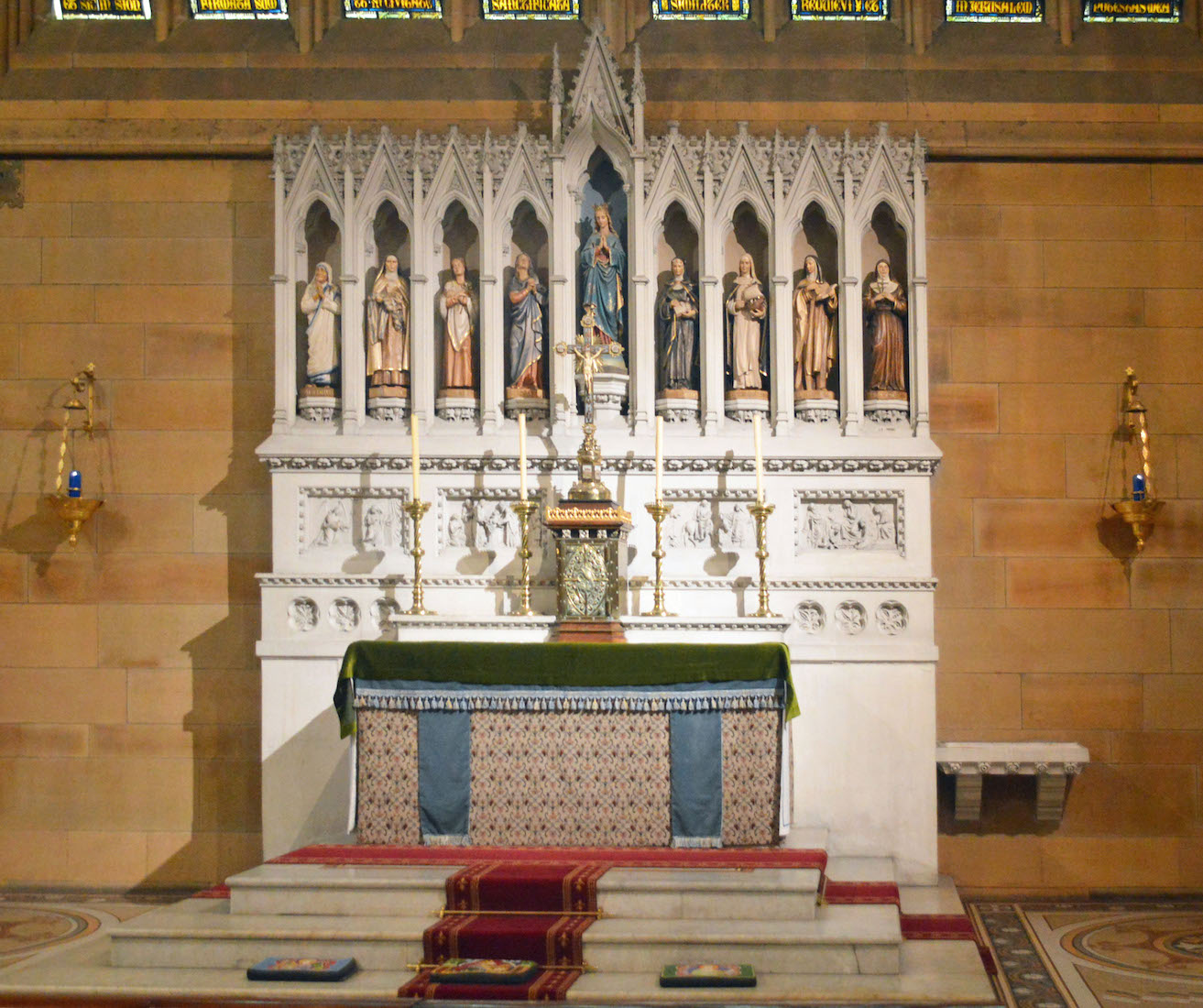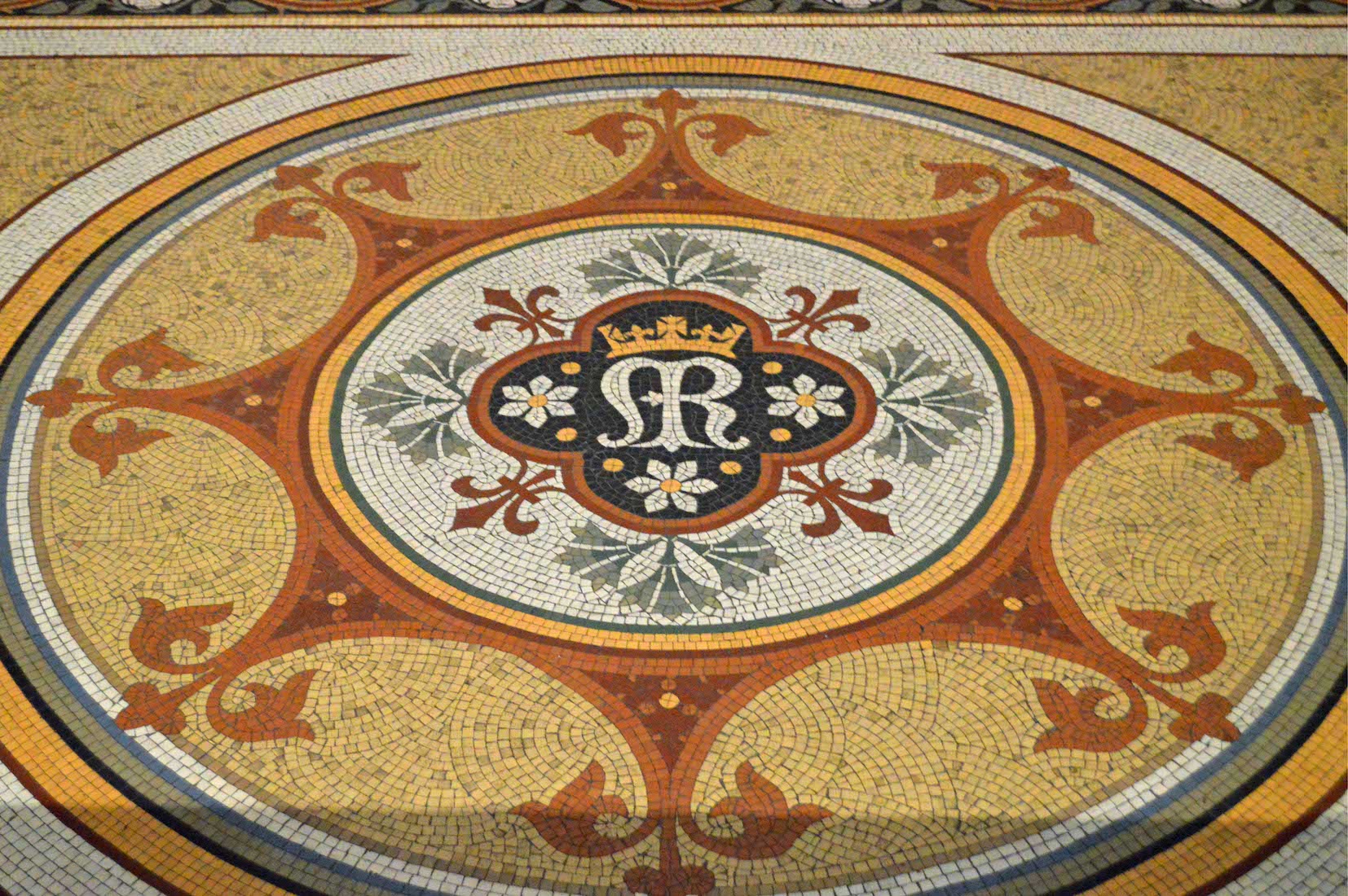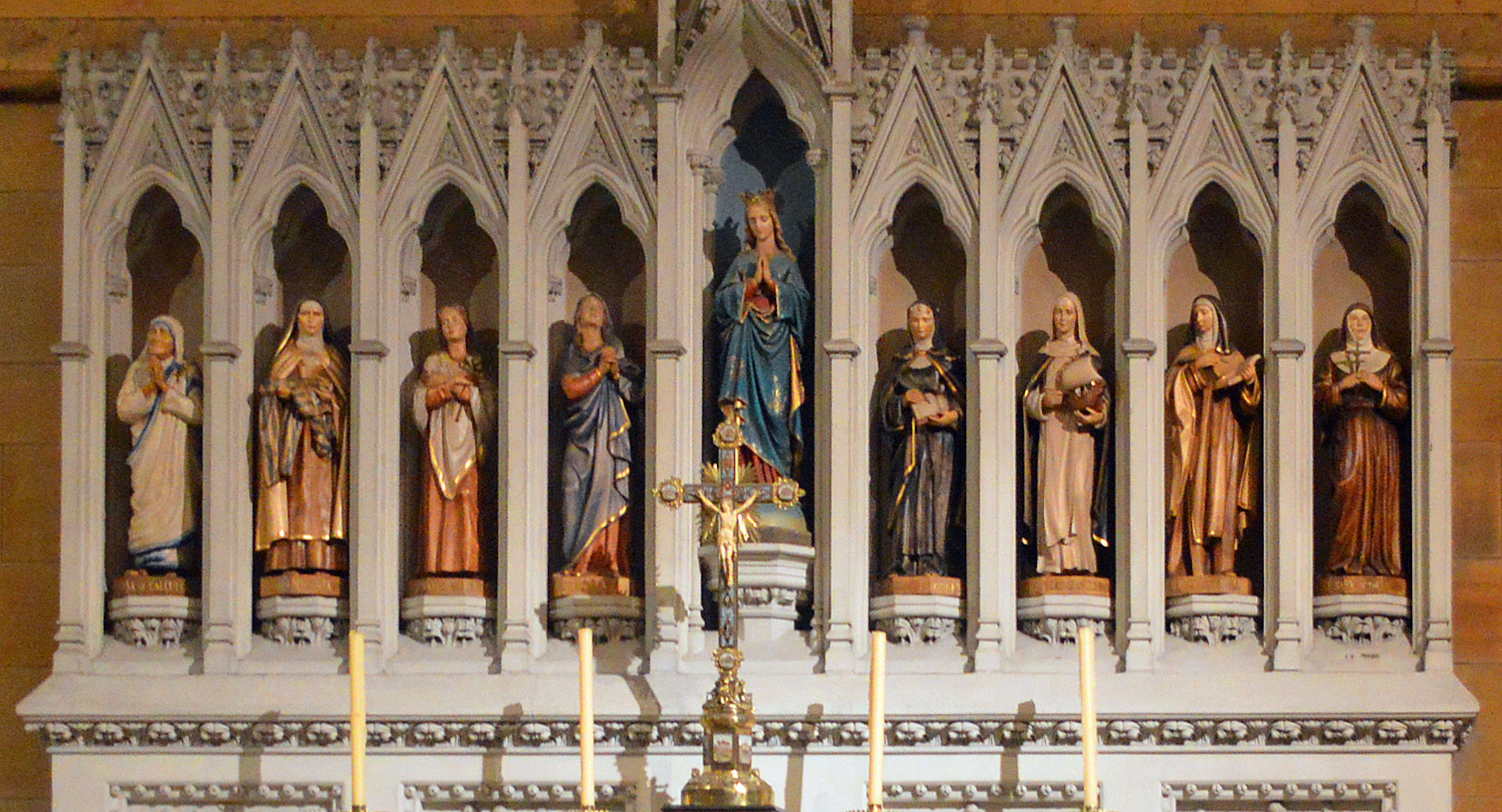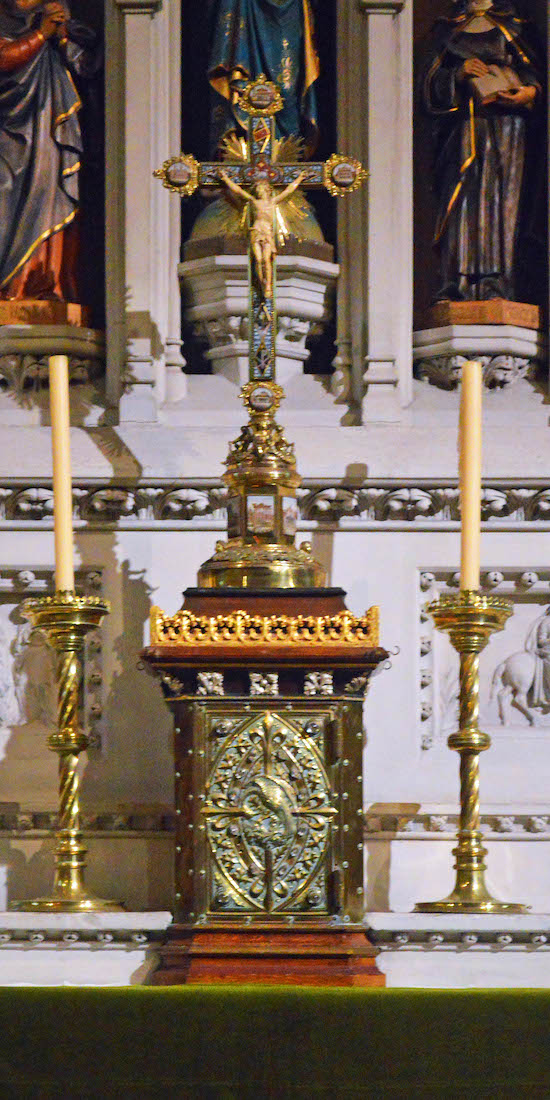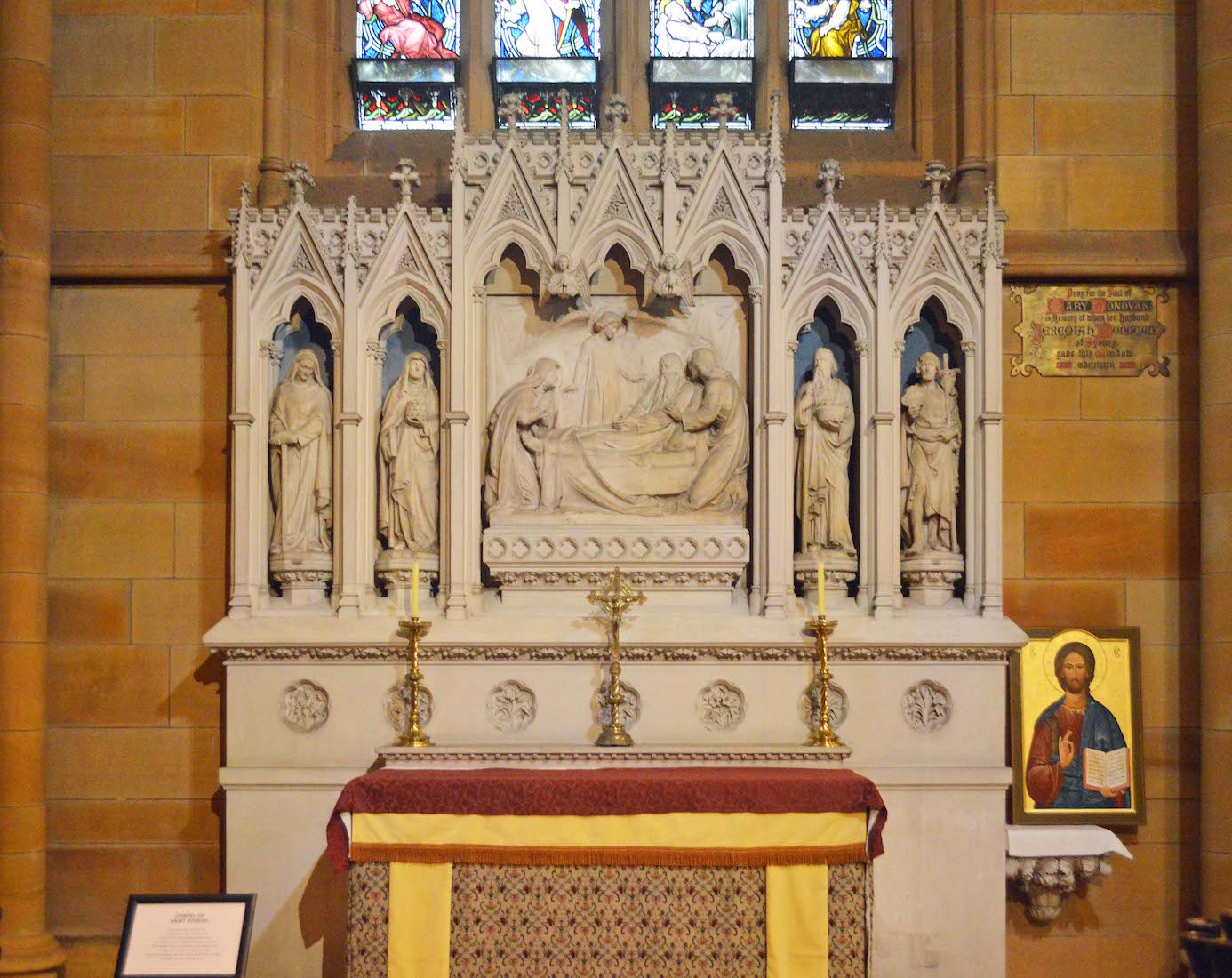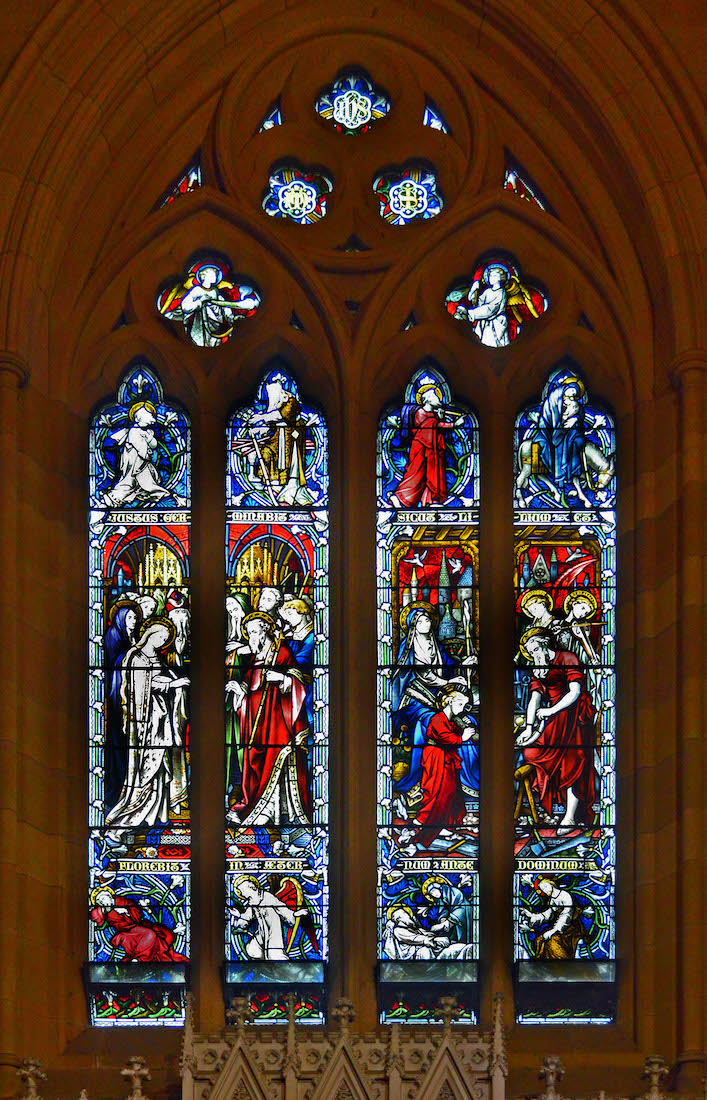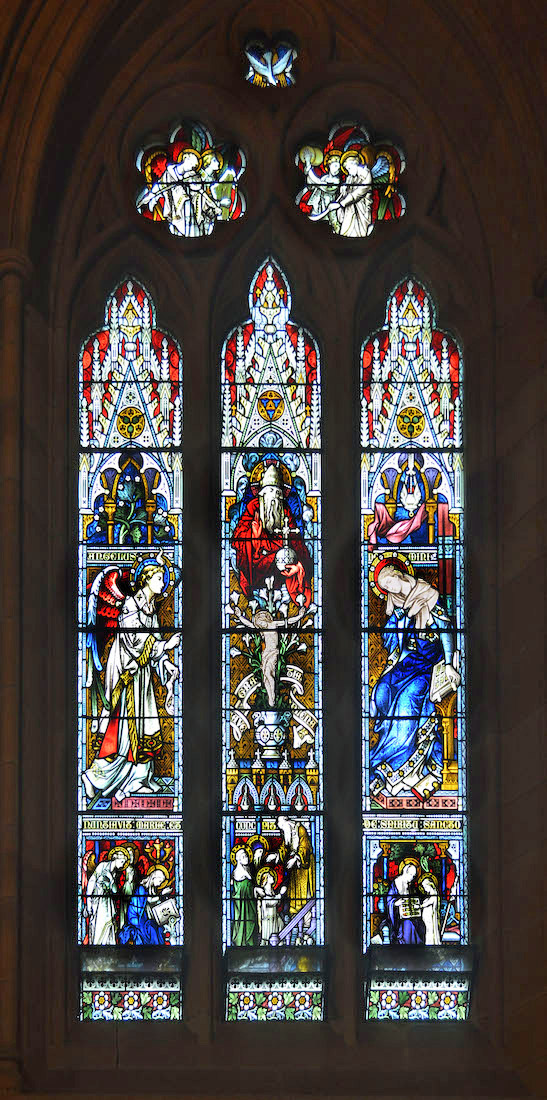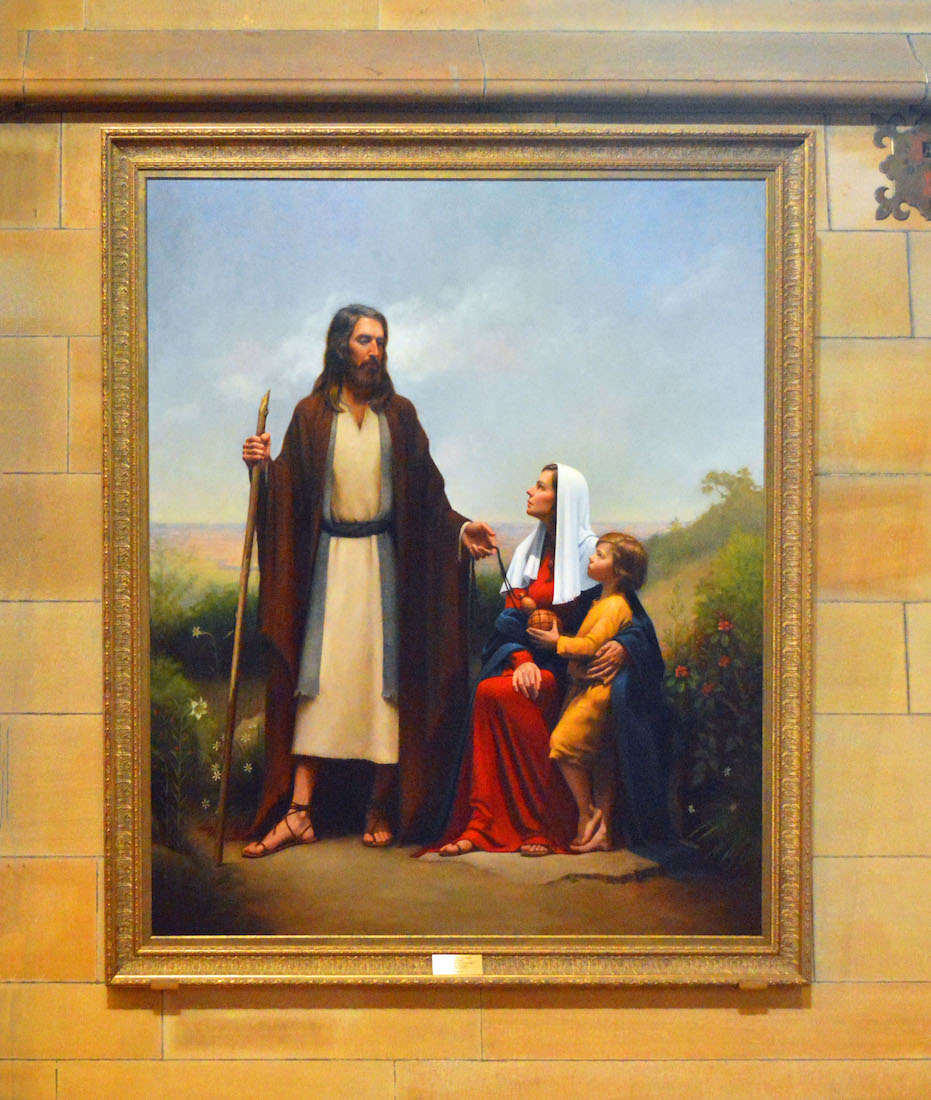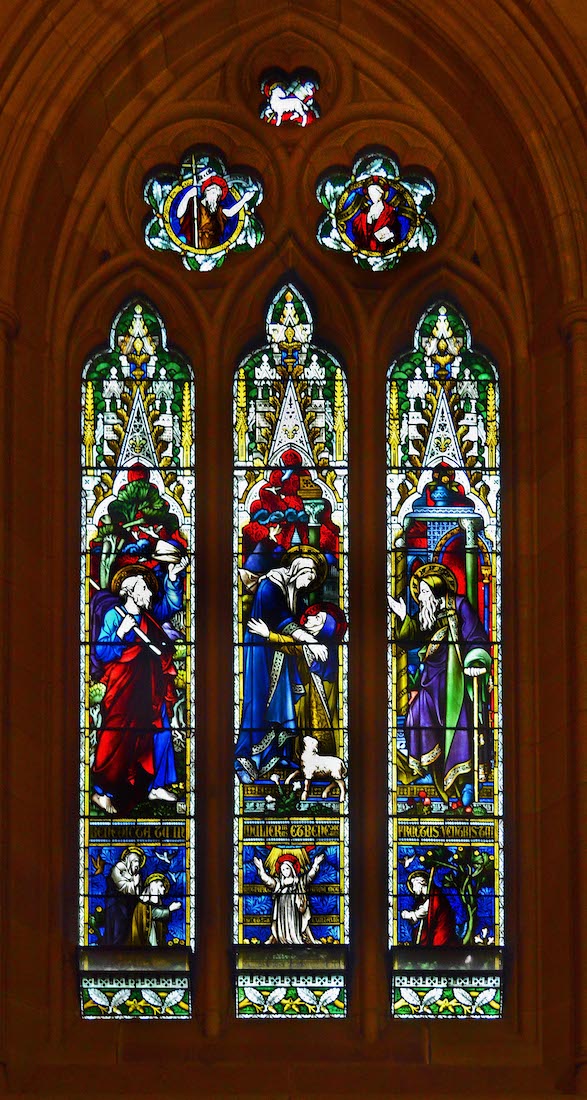61. ST JOSEPH AND SOUTH CHANCEL WINDOW
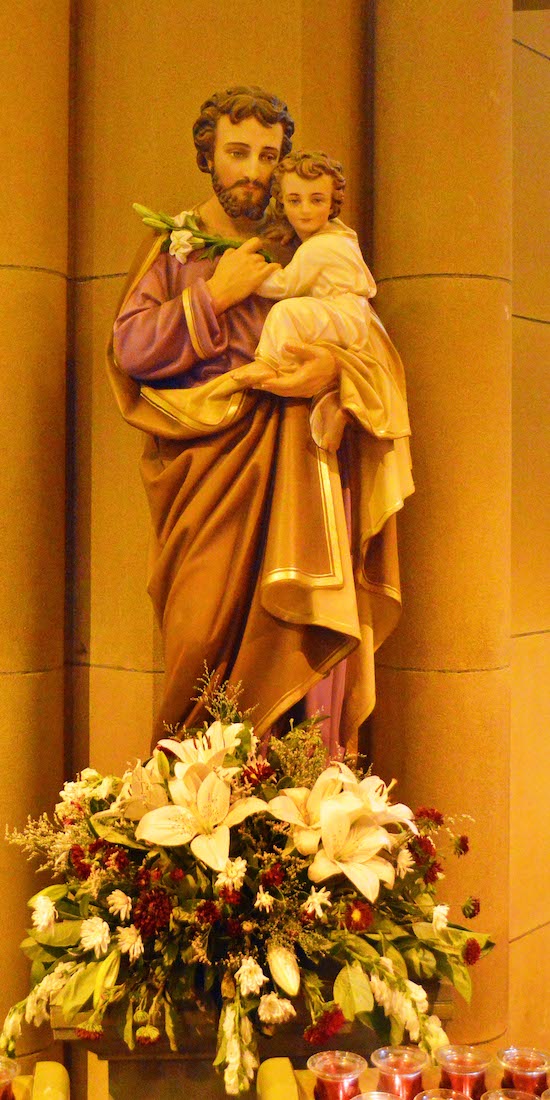
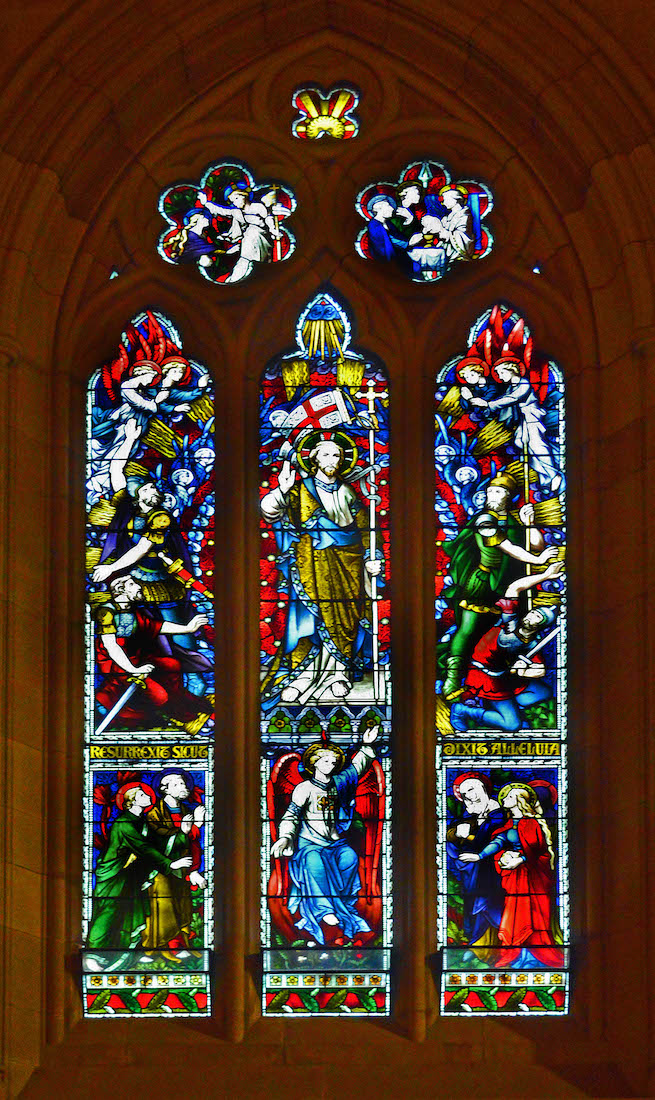
We walk down to the statue of St Joseph holding the Christ Child. Joseph is often pictured holding a shooting sprig – a reference to an old legend relating to the coming birth of Christ in his family. •• The window in the South wall of the same bay shows the 1st Glorious Mystery of the Rosary. The text reads: ‘Resurrexit Sicut Dixit Alleluia’ – an ancient Latin expression meaning ‘He is risen as He said! Alleluia!’ So we have pictured the risen Christ, startled soldiers, wondering disciples, and a worshiping angel. PLAN
62. CHAPEL OF IRISH SAINTS
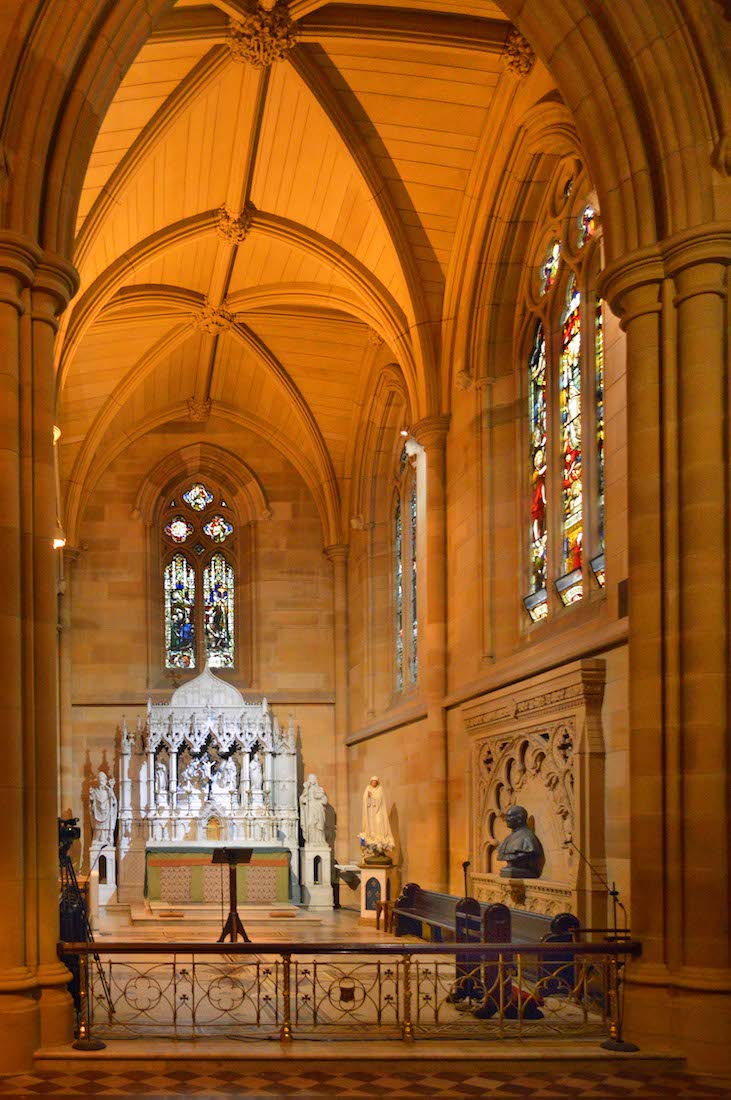
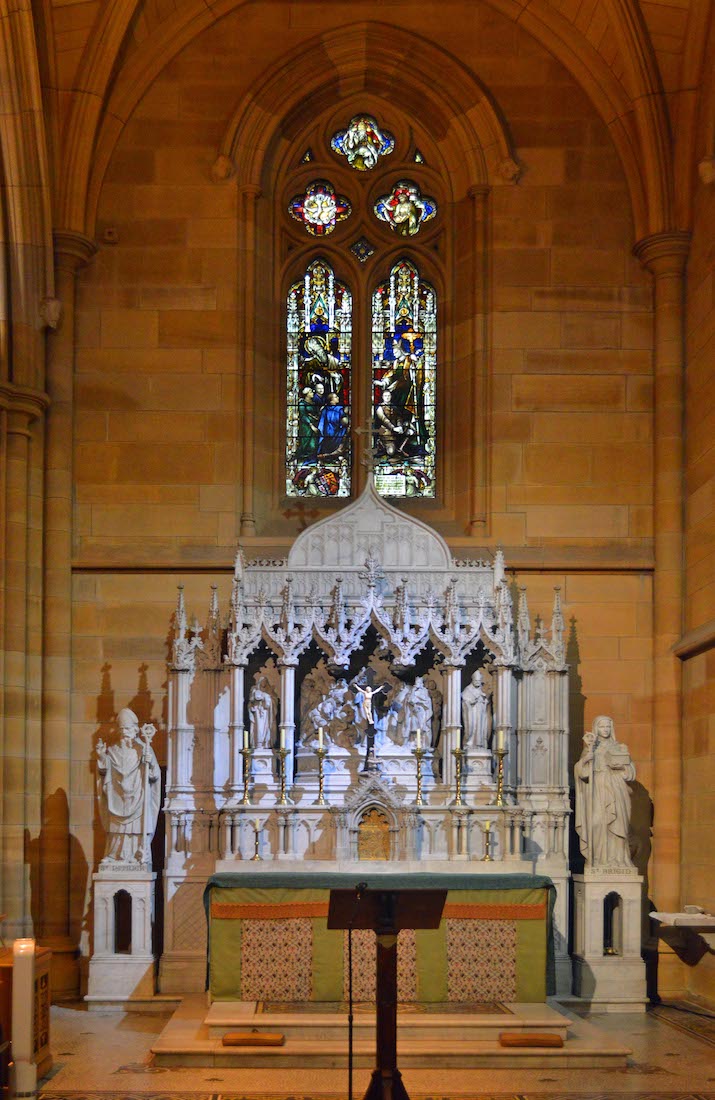
On our left is the Chapel of Irish saints. At the East end stands an altar, a white reredos depicting the crucifixion, and statues of St Patrick and St Brigid to the sides. On the left wall is a monument to Bishop Moran and a statue of the Virgin Mary. The chapel has three stained glass windows.
63. CHAPEL TILING AND VIRGIN MARY
The floor of the Chapel, laid by Peter Molocco, exhibits some of the wonderful mosaic tiling to be found at the East end of this Cathedral. At right is a statue of Mary standing on a cloud. There are South American devotions to ‘The Virgin of the Clouds‘.
64. CHAPEL SOUTH WALL AND WINDOW
On the South wall of the Chapel of Irish Saints there is a stained glass window which is a memorial to John Henry Cardinal Newman. Cardinal Newman appears bottom centre. The window shows Jesus as the Light of the world, based on John 1:9 : ‘There was the true Light which, coming into the world, enlightens every man’. The side panels show various saints who have in some way testified to the Light, and at bottom, the patron saints of John Newman. ••• The memorial below is made of Waverley sandstone and commemorates the life of Francis Patrick Cardinal Moran.
65. CARDINAL MORAN MONUMENT
Patrick Francis Cardinal Moran (1830 – 1911) was the third Roman Catholic Archbishop of Sydney and the first cardinal appointed from Australia. Moran was considered so intellectually bright that he gained his doctorate by acclamation. By twenty-five he spoke ten languages, ancient and modern. He focused on finding and editing important documents and manuscripts related to Irish ecclesiastical history. Some editions of his works remain important source materials to this day. Moran was personally chosen and promoted by Pope Leo XIII to head the Archdiocese of Sydney. During his episcopate, Moran consecrated 14 bishops, ordained nearly 500 priests, dedicated more than 5000 churches, and professed more than 500 nuns. There is a statue of Moran outside by the West door of the Cathedral.
66. CHAPEL WINDOW AND ST PATRICK
St Patrick is one of the Irish saints standing alongside the altar (the other is St Brigid). ••• Above the altar is a two-lancet window depicting Irish St Brendan at left and St Patrick at right. ••• To the right of the altar is the English Benedictines Memorial Window. The window shows Pope Gregory the Great sending Augustine to convert the English. In 597, Augustine with around forty other religious figures arrived on the shores of the Kent coast to convert King Ethelbert and his kingdom to Christianity.
67. NEAR THE SACRISTY ENTRANCE
We leave the Chapel of Irish Saints and return to the South chancel aisle. There are a couple of doors leading through to the private area of the sacristy. On the wall between the two doors hangs a small bell. The ends of the door-arches are decorated with the heads of various saints – a feature throughout the Cathedral. We notice too that there are three stained glass windows along this wall.
68. SOUTH CHANCEL AISLE WINDOWS
These windows in the South chancel aisle illustrate the 3rd and 2nd Glorious Mysteries of the Rosary. ••• At left (GMR3) Mary is shown at centre with arms crossed in prayer on the Day of Pentecost. The twelve apostles (with Matthias) appear in an agitated state with tongues of fire above their heads. The text reads: ‘The Spirit of the Lord wills the whole world, Alleluia’. ••• The window at right (GMR2) shows the Ascension of Christ, with Mary and four of the apostles watching on. The text reads: ‘ He ascended into heaven’.
69. SOUTH RECESS OF THE AMBULATORY
The East chancel aisle runs into a North – South cross aisle labelled The Ambulatory on the Plan. At the South end there is a recess with three arches containing a statue.
70. ST ANNE AND ST MARY, CRUCIFIX
The statue shows St Anne teaching her daughter, the young Mary, to read. The idea is found in certain Apocryphal writings. •• On the same wall, just East of the recess is a crucifix.
71. ST PETER’S CHAPEL WINDOWS
We are coming to the Chapel of St Peter in the Southeast corner of the Cathedral, and here we find an East window (left) and a South window (right). The South window is above the crucifix. The window at left illustrates Matthew 16:18 where Jesus says to Peter: You are Peter (rock) and upon this rock I will build my church. In the left panels the disciples are pulling in a large catch of fish; in the right panels Jesus is giving Peter the Keys of the Kingdom(!). •• The window at right illustrates the Assumption of the Virgin Mary – a dogma of the Roman Catholic Church defined in 1950. This is the 4th Glorious Mystery of the Rosary.
72. ST PETER’S CHAPEL
At left is a view of St Peter’s Chapel with the window above. •• In front of the altar is a many-branched candle stand.
73. PAPAL UMBRELLA, ST PETER’S CHAPEL REREDOS
To the left of the altar is the umbraculum or Papal Umbrella. This is a sign that the Cathedral has been given the status of being a basilica – a conferment which involves special privileges. ••• The reredos behind the altar shows St Peter receiving the Keys of the Kingdom from Christ. In both the Old and New Testaments, keys symbolize power and authority. So through Peter’s faithful proclamation of the gospel, Peter will open the door of the kingdom to those who respond in faith, while at the same time keeping it shut from those who do not.
74. EAST END
These are views across the East ambulatory. There are three chapels here: the Chapel of St Joseph is the far corner, the Lady Chapel at centre, and the Chapel of St Peter, out of view but at our right. Notice the great East window behind the Lady Chapel altar. Also, the left view gives us some details of the North wall: a similar recess with three arches, two stained glass windows, and a painting – just visible behind the column.
75. GREAT EAST WINDOW
This Great East Window has several related themes. Across the bottom are scenes of the fall of man, with Eve tempting Adam with the apple, and Adam and Eve being driven from the Garden of Eden. The main central panels show Mary, crowned and enthroned beside Jesus as he sits in judgement, pleading God’s mercy upon Christians. Thus the window primarily depicts the 5th Glorious Mystery of the Rosary. [Photo Credit: Wikimedia Jason7825]
76. LADY CHAPEL AND MOSAIC TILING
Beneath the Great East Window is the Lady Chapel with its decorated mosaic flooring including the ‘MR’ symbol for Mary Regina (Queen). This Chapel appears to have become the Chapel of the Blessed Sacrament.
77. LADY CHAPEL SAINTS AND TABERNACLE
The reredos of the Lady Chapel features Our Lady at the centre, and has four women saints on either side. I suspect the name of each is written on the base, but I am unable to decipher these. Mother Teresa of Calcutta stands in the left-most niche.
78. ST JOSEPH’S CHAPEL AND WINDOW
In the Northeast corner of the Cathedral we find St Joseph’s Chapel. The altar niches contain statues of St Joachim and St Anne (by tradition, parents of the Blessed Virgin), and St Elizabeth and St John the Baptist. The central scene is possibly the death of St Joseph? •• The four-lancet window behind has Latin text translating to ‘just as the lily will bloom forever before’: a reference to the legend of the sprouting sprig which Joseph held before the birth of Christ, which indicated that Christ would be born into his family. At left is pictured the wedding of Mary and Joseph. At right is a scene of the Holy Family at home in Nazareth with Jesus learning carpentry from his foster-father Joseph.
79. ST JOSEPH’S CHAPEL, WINDOW AND PAINTING
On the North (left) side of St Joseph’s Chapel is a stained glass window and a painting. ••• The window depicts the Annunciation: the 1st Joyful Mystery of the Rosary, with the Angel Gabriel at left announcing to Mary that she is going to be the mother of the on of the Most High. At centre is a small lily-crucifix – a curious combination arising from a medieval belief that the Annunciation and the Crucifixion took place on the same day, March 25th.. ••• The commissioned painting, by local artist Sally Ryan, was unveiled on May 1, 2022, and shows Joseph, Mary and Jesus.
80. NORTH CHANCEL AISLE WINDOWS
Following West up the North aisle we find two another stained glass window. this window shows The Visitation, the 2nd Joyful Mystery of the Rosary. Here the scene is of St Elizabeth and St Mary as told in Luke 1:42. Elizabeth exclaims ‘Blessed are you among women, and blessed is the fruit of your womb’.


